The Air Quality Impact Evaluation of Modular Construction Practices in Hong Kong and Singapore
Abstract
:1. Introduction
2. Literature Review
2.1. The Effects of Modular Construction
2.2. Modular Construction’s Impact on Air Quality
2.3. Factors Affecting Air Quality
3. Background—The Development of Modular Construction in Hong Kong and Singapore
3.1. Development of Modular Construction in Hong Kong
3.2. Development of Modular Construction in Hong Kong
4. Methodology
4.1. Research Design
4.2. Data Description
4.2.1. Data Source
4.2.2. Selection and Interpretation of Variables
4.3. Empirical Specification
5. Results and Discussion
5.1. The DID Result Analysis and Discussion
5.1.1. The DID Result Analysis and Discussion between Singapore and Hong Kong from 1998 to 2002
5.1.2. The DID Result Analysis and Discussion between Singapore and Hong Kong from 1998 to 2002
5.2. The OLS Results Analysis and Discussion
5.2.1. The OLS Results Analysis and Discussion of Hong Kong from 1998 to 2018
5.2.2. The OLS Results Analysis and Discussion of Singapore from 1998 to 2018
6. Conclusions and Implications
Author Contributions
Funding
Institutional Review Board Statement
Informed Consent Statement
Data Availability Statement
Acknowledgments
Conflicts of Interest
Appendix A. Development of Hong Kong’s Modular Construction
| Policy/Regulation/Code | Key Contents | References |
|---|---|---|
| Joint Practice Note No. 1 | The cumulative total building area exemption of all green functions (excluding sky garden and podium garden) should not exceed 8% of the total permitted building area of the development project. | [63] |
| Joint Practice Note No. 2 | If the conditions are met, non-structural prefabricated exterior walls and modular integrated buildings can be exempted from total floor area and/or site coverage. | [64] |
| Code of Practice for Precast Concrete Construction | As far as possible, the use of standardised precast concrete components should be planned for buildings that use precast concrete buildings. | [65] |
| Increased production tolerances and installation tolerances | [66] |
Appendix B. Development of Singapore’s Modular Construction
| Policy/Regulation/Code | Key Contents | References |
|---|---|---|
| Code of Practice on Buildable Design | If the submitted buildability score is lower than the minimum required score, it will not be approved. Prefabricated components have been incorporated into the practice guidelines, and the use of prefabricated components can increase the buildability score of the building. | [51] |
| The minimum buildability score requirement remains unchanged. Adjustment of influencing factors. | [67] | |
| The minimum buildability score requirement is increased. Adjustment of influencing factors. | [68] | |
| The minimum buildability score requirement is increased. Adjustment of influencing factors. Use prefabricated parts to gain extra points | [69] | |
| The minimum buildability score requirement is increased. The Constructability Appraisal System (CAS) is newly added, and it is used as the building evaluation standard together with the Buildable Design Appraisal System (BDAS). | [70] | |
| The minimum constructability score requirement is increased. Adjustment of influencing factors. The minimum constructability score is increased. | [71] | |
| The minimum constructability score requirement is increased. Adjustment of influencing factors. The minimum constructability score is increased. | [72] | |
| The minimum constructability score requirement is increased. Adjustment of influencing factors. The minimum constructability score is increased. | [73] | |
| The minimum constructability score requirement remains unchanged, and the minimum constructability score remains unchanged. Added the minimum buildable design score for the basement of all new construction projects. | [74] |
Appendix C. Augmented Dickey–Fuller Test of Unit Root of Each Variable in Hong Kong
| Augmented Dickey–Fuller | ||||
|---|---|---|---|---|
| Variables | Test Statistic | 1% Critical Value | 5% Critical Value | 10% Critical Value |
| 1 | 1.774 | −3.750 | −3.000 | −2.630 |
| 2 | −1.884 | −3.750 | −3.000 | −2.630 |
| 3 | −3.084 | −3.750 | −3.000 | −2.630 |
| 4 | 0.442 | −3.750 | −3.000 | −2.630 |
| 5 | −1.921 | −3.750 | −3.000 | −2.630 |
| 6 | 0.161 | −3.750 | −3.000 | −2.630 |
| 7 | −2.626 | −3.750 | −3.000 | −2.630 |
| 8 | 2.923 | −3.750 | −3.000 | −2.630 |
Appendix D. Augmented Dickey–Fuller Test of Unit Root of Each Variable in Singapore
| Augmented Dickey-Fuller | ||||
|---|---|---|---|---|
| Variables | Test Statistic | 1% Critical Value | 5% Critical Value | 10% Critical Value |
| 1 | −0.424 | −3.750 | −3.000 | −2.630 |
| 2 | −0.811 | −3.750 | −3.000 | −2.630 |
| 3 | −1.071 | −3.750 | −3.000 | −2.630 |
| 4 | −0.461 | −3.750 | −3.000 | −2.630 |
| 5 | −1.408 | −3.750 | −3.000 | −2.630 |
| 6 | −4.072 | −3.750 | −3.000 | −2.630 |
| 7 | −1.132 | −3.750 | −3.000 | −2.630 |
| 8 | −1.363 | −3.750 | −3.000 | −2.630 |
References
- Haapio, A.; Viitaniemi, P. A critical review of building environmental assessment tools. Environ. Impact Assess. Rev. 2008, 28, 469–482. [Google Scholar] [CrossRef]
- Crawley, D.; Aho, I. Building environmental assessment methods: Applications and development trends. Build. Res. Inf. 1999, 27, 300–308. [Google Scholar] [CrossRef]
- Amiri, A.; Caddock, P.; Whitehead, M. Accounting for the greenhouse gas emissions of construction: A UK case study. Proc. Inst. Civ. Eng. Civ. Eng. 2013, 166, 82–88. [Google Scholar] [CrossRef]
- Kamali, M.; Hewage, K. Life cycle performance of modular buildings: A critical review. Renew. Sustain. Energy Rev. 2016, 62, 1171–1183. [Google Scholar] [CrossRef]
- Xu, Z.; Zayed, T.; Niu, Y. Comparative analysis of modular construction practices in mainland China, Hong Kong and Singapore. J. Clean. Prod. 2020, 245, 118861. [Google Scholar] [CrossRef]
- Kamali, M.; Hewage, K.; Sadiq, R. Conventional versus modular construction methods: A comparative cradle-to-gate LCA for residential buildings. Energy Build. 2019, 204, 109479. [Google Scholar] [CrossRef]
- Quale, J.; Eckelman, M.J.; Williams, K.W.; Sloditskie, G.; Zimmerman, J.B. Construction matters: Comparing environmental impacts of building modular and conventional homes in the United States. J. Ind. Ecol. 2012, 16, 243–253. [Google Scholar] [CrossRef]
- Lawson, M.; Ogden, R.; Goodier, C. Design in Modular Construction; CRC Press: Boca Raton, FL, USA, 2014. [Google Scholar]
- Lee, K.B.; Kim, K.R.; Shin, D.W.; Cha, H.S. A proposal for optimizing unit modular system process to improve efficiency in off-site manufacture, transportation and on-site installation. Korean J. Constr. Eng. Manag. 2011, 12, 14–21. [Google Scholar] [CrossRef] [Green Version]
- Staib, G.; Dörrhöfer, A.; Rosenthal, M. Components and Systems: Modular Construction–Design, Structure, New Technologies; Walter de Gruyter: Berlin, Germany, 2013. [Google Scholar]
- Liu, S.; Qian, S. Evaluation of social life-cycle performance of buildings: Theoretical framework and impact assessment approach. J. Clean. Prod. 2019, 213, 792–807. [Google Scholar] [CrossRef]
- Kamali, M.; Hewage, K. Development of performance criteria for sustainability evaluation of modular versus conventional construction methods. J. Clean. Prod. 2017, 42, 3592–3606. [Google Scholar] [CrossRef]
- Hammad, A.W.; Akbarnezhad, A.; Wu, P.; Wang, X.; Haddad, A. Building information modelling-based framework to contrast conventional and modular construction methods through selected sustainability factors. J. Clean. Prod. 2019, 228, 1264–1281. [Google Scholar] [CrossRef]
- Hong, J.; Shen, G.; Li, Z.; Zhang, B.; Zhang, W. Barriers to promoting prefabricated construction in China: A cost-benefit analysis. J. Clean. Prod. 2018, 172, 649–660. [Google Scholar] [CrossRef]
- Miller, W.F. Energy and Environmental Benefits of Structural Insulated Panels for Residential Construction in Australia; Metecno Pty Ltd.: Brisbane, Australia, 2010. [Google Scholar]
- Pan, W.; Sidwell, R. Demystifying the cost barriers to offsite construction in the UK. Constr. Manag. Econ. 2011, 29, 1081–1099. [Google Scholar] [CrossRef]
- Salama, T.; Salah, A.; Moselhi, O.; Al-Hussein, M. Near optimum selection of module configuration for efficient modular construction. Autom. Constr. 2017, 83, 316–329. [Google Scholar] [CrossRef]
- Liu, C.; Chen, J. Study on Influence of Prefabricated Rate on the Cost of Prefabricated Building. In Proceedings of the ICCREM 2019: Innovative Construction Project Management and Construction Industrialization, Banff, AB, Canada, 21–24 May 2019; pp. 554–561. [Google Scholar]
- Luo, S.; Li, S. Quantitative analysis of the influence of prefabrication on construction cost. Constr. Econ. 2016, 37, 48–53. [Google Scholar]
- Zhang, W.; Lee, M.W.; Jaillon, L.; Poon, C.S. The hindrance to using prefabrication in Hong Kong’s building industry. J. Clean. Prod. 2018, 204, 70–81. [Google Scholar] [CrossRef]
- Lu, W.; Yuan, H. Investigating waste reduction potential in the upstream processes of offshore prefabrication construction. Renew. Sustain. Energy Rev. 2013, 28, 804–811. [Google Scholar] [CrossRef] [Green Version]
- Liew, K.H. Manifestos for Sustainable Development: Sustainable Modular Steel-Precast Concrete Building Construction System for Dwellings in Singapore. In Sustainable Development Research in the Asia-Pacific Region; Leal Filho, W., Rogers, J., Iyer-Raniga, U., Eds.; World Sustainability Series; Springer: Cham, Switzerland, 2018; pp. 477–492. [Google Scholar]
- Cao, X.; Li, X.; Zhu, Y.; Zhang, Z. A comparative study of environmental performance between prefabricated and traditional residential buildings in China. J. Clean. Prod. 2015, 109, 131–143. [Google Scholar] [CrossRef]
- Dong, Y.; Jaillon, L.; Chu, P.; Poon, C.S. Comparing carbon emissions of precast and cast-in-situ construction methods—A case study of high-rise private building. Constr. Build. Mater. 2015, 99, 39–53. [Google Scholar] [CrossRef]
- Li, Z.; Shen, G.; Alshawi, M. Measuring the impact of prefabrication on construction waste reduction: An empirical study in China. Resour. Conserv. Recycl. 2014, 91, 27–39. [Google Scholar] [CrossRef] [Green Version]
- Tavares, V.; Lacerda, N.; Freire, F. Embodied energy and greenhouse gas emissions analysis of a prefabricated modular house: The “Moby” case study. J. Clean. Prod. 2019, 212, 1044–1053. [Google Scholar] [CrossRef]
- Jaillon, L.; Poon, C.S. Sustainable construction aspects of using prefabrication in dense urban environment: A Hong Kong case study. Constr. Manag. Econ. 2008, 26, 953–966. [Google Scholar] [CrossRef]
- Rahman, M.; Sobuz, H.R. Comparative study of IPS & PPVC precast system—A case study of public housing buildings project in Singapore. In Proceedings of the 4th International Conference on Civil Engineering for Sustainable Development (ICCESD 2018), KUET, Khulna, Bangladesh, 9–11 February 2018; Volume 4149, pp. 1–12. [Google Scholar]
- Zhao, P.; Feng, Y.; Jin, J.; Han, B.; Bi, X.; Zhu, T.; Zhang, X. Characteristics and control indicators of fugitive dust from building construction sites. Acta Sci. Circumstantiae 2009, 29, 1618–1623. [Google Scholar]
- Teng, Y.; Li, K.; Pan, W.; Ng, T. Reducing building life cycle carbon emissions through prefabrication: Evidence from and gaps in empirical studies. Build. Environ. 2018, 132, 125–136. [Google Scholar] [CrossRef]
- Kawecki, L.R. Environmental Performance of Modular Fabrication: Calculating the Carbon Footprint of Energy Used in the Construction of a Modular Home. Ph.D. Thesis, Arizona State University, Tempe, AZ, USA, 2010. [Google Scholar]
- Pons, O.; Wadel, G. Environmental impacts of prefabricated school buildings in Catalonia. Habitat Int. 2011, 35, 553–563. [Google Scholar] [CrossRef]
- Al-Hussein, M.; Manrique, J.D.; Mah, D. North Ridge CO2 Analysis Report: Comparison between Modular and On-Site Construction; University of Alberta: Edmonton, AB, Canada, 2009. [Google Scholar]
- Dodoo, A.; Gustavsson, L.; Sathre, R. Lifecycle carbon implications of conventional and low-energy multi-storey timber building systems. Energy Build. 2014, 82, 194–210. [Google Scholar] [CrossRef]
- Pan, W.; Li, K.; Teng, Y. Briefing: Life-cycle carbon assessment of prefabricated buildings: Challenges and solutions. Proc. Inst. Civ. Eng. Eng. Sustain. 2018, 172, 3–8. [Google Scholar] [CrossRef]
- Xing, J.; Wang, S.; Chatani, S.; Zhang, C.; Wei, W.; Hao, J.; Klimont, Z.; Cofala, J.; Amann, M. Projections of air pollutant emissions and its impacts on regional air quality in China in 2020. Atmos. Chem. Phys. 2011, 11, 3119–3136. [Google Scholar] [CrossRef] [Green Version]
- Ni, T.; Han, B.; Bai, Z. Source apportionment of PM10 in four cities of northeastern China. Aerosol Air Qual. Res. 2012, 12, 571–582. [Google Scholar] [CrossRef] [Green Version]
- Sik, K.Y.; Choi, W.; Joong, O.K. A Study of the amount of fugitive dust generated from new harbor construction site and the prediction of effect using Aermod. J. Environ. Health Sci. 2009, 35, 304–314. [Google Scholar]
- Du, Y.; Ren, H.; Cai, W.; Qin, B.; Ma, X. Effect of Construction Dust on Urban PM 2.5 Emission Characteristics: A Case Study of the Main Urban Area of Chongqing, China. Nature Environ. Pollut. Technol. 2016, 15, 833–840. [Google Scholar]
- Chang, C.; Chang, Y.; Lin, W.; Wu, M. Fugitive dust emission source profiles and assessment of selected control strategies for particulate matter at gravel processing sites in Taiwan. J. Air Waste Manag. Assoc. 2010, 60, 1262–1268. [Google Scholar] [CrossRef] [Green Version]
- Celine, J.L. The Evolution of the Use of Prefabrication Techniques in Hong Kong Construction Industry. Ph.D. Thesis, Hong Kong Polytechnic University, Hong Kong, China, 2009. [Google Scholar]
- Lawson, M.; Ogden, R.; Bergin, R. Application of modular construction in high-rise buildings. J. Archit. Eng. 2012, 18, 148–154. [Google Scholar] [CrossRef]
- Velasco, E.; Roth, M. Review of Singapore’s air quality and greenhouse gas emissions: Current situation and opportunities. J. Air Waste Manag. Assoc. 2012, 62, 625–641. [Google Scholar] [CrossRef] [Green Version]
- Zhan, S. Research on Changing Trend and Influencing Factors of Conventional Air Pollutants in Guangdong-Hongkong-Macao Greater Bay Area. Ph.D. Thesis, University of Chinese Academy of Sciences, Guangzhou, China, 2018. [Google Scholar]
- Zhang, X.; Gong, Z. Spatiotemporal characteristics of urban air quality in China and geographic detection of their determinants. J. Geogr. Sci. 2018, 28, 563–578. [Google Scholar] [CrossRef] [Green Version]
- World Health Organization (WHO). Ambient (Outdoor) Air Pollution. 2021. Available online: https://www.who.int/news-room/fact-sheets/detail/ambient-(outdoor)-air-quality-and-health (accessed on 22 September 2021).
- Mak, Y.W. Prefabrication and Industrialisation of Housing in Hong Kong. Master’s Thesis, Hong Kong Polytechnic University, Hong Kong, China, 1998. [Google Scholar]
- Cen, Y.; Deng, W.M. The development of prefabricated buildings in Hong Kong. Hous. Ind. 2017, 12, 15–21. [Google Scholar]
- Ting, S.K.; Jin, H.F. Prefabrication in the Singapore Construction Industry. In Proceedings of the 17th IAARC/CIB/IEEE/IFAC/IFR International Symposium on Automation and Robotics in Construction: 17th ISARC 2000, Taipei, Taiwan, 18–20 September 2000; Volume 66, pp. 1–6. [Google Scholar]
- Building and Construction Authority. Annex C Buildable Score Appraisal System. 2017. Available online: https://www.bca.gov.sg/Publications/BuildabilitySeries/others/rscp_anxc.PDF (accessed on 25 September 2017).
- Building and Construction Authority. Code of Practice on Buildable Design. 2000. Available online: https://www1.bca.gov.sg/docs/default-source/docs-corp-news-and-publications/publications/for-industry/buildability-series/copbddec00.pdf (accessed on 30 December 2021).
- Park, M.; Ingawale-Verma, Y.; Kim, W.; Ham, Y. Construction policymaking: With an example of Singaporean government’s policy to diffuse prefabrication to private sector. KSCE J. Civ. Eng. 2011, 15, 771–779. [Google Scholar] [CrossRef]
- Gao, Y. Research on the development of prefabricated Buildings in Singapore. Hous. Ind. 2016, 6, 45–49. [Google Scholar]
- Ellis, P. Uncertainty in the Hong Kong Special Administrative Region. (HKSAR). Bus. Horiz. 1997, 40, 59–64. [Google Scholar] [CrossRef]
- Aye, L.; Ngo, T.; Crawford, R.H.; Gammampila, R.; Mendis, P. Life cycle greenhouse gas emissions and energy analysis of prefabricated reusable building modules. Energy Build. 2012, 47, 159–168. [Google Scholar] [CrossRef]
- Mao, C.; Shen, Q.; Shen, L.; Tang, L. Comparative study of greenhouse gas emissions between off-site prefabrication and conventional construction methods: Two case studies of residential projects. Energy Build. 2013, 66, 165–176. [Google Scholar] [CrossRef] [Green Version]
- Cole, M.A.; Neumayer, E. Examining the Impact of Demographic Factors on Air Pollution. Popul. Environ. 2004, 26, 5–21. [Google Scholar] [CrossRef] [Green Version]
- Qiu, G.; Song, R.; He, S. The aggravation of urban air quality deterioration due to urbanization, transportation and economic development–Panel models with marginal effect analyses across China. Sci. Total Environ. 2019, 651, 1114–1125. [Google Scholar] [CrossRef]
- Lonati, G.; Cernuschi, S.; Sidi, S. Air quality impact assessment of at-berth ship emissions: Case-study for the project of a new freight port. Sci. Total Environ. 2010, 409, 192–200. [Google Scholar] [CrossRef] [PubMed]
- Zhang, K.; Batterman, S. Air pollution and health risks due to vehicle traffic. Sci. Total Environ. 2013, 450, 307–316. [Google Scholar] [CrossRef] [Green Version]
- Chan, A.P.C. Modelling building durations in Hong Kong. Constr. Manag. Econ. 1999, 17, 189–196. [Google Scholar] [CrossRef]
- South China Moring Post. Singapore is Embracing ‘Lego Style’ Prefabricated Construction Method for Residential Housing. 2019. Available online: https://www.scmp.com/property/international/article/3017734/singapore-embracing-lego-style-prefabricated-construction (accessed on 8 July 2019).
- Buildings Department. Joint Practice Note No. 1. 2001. Available online: https://www.bd.gov.hk/doc/en/resources/codes-and-references/practice-notes-and-circular-letters/joint/JPN01.pdf (accessed on 30 December 2021).
- Buildings Department. Joint Practice Note No. 2. 2002. Available online: https://www.bd.gov.hk/doc/en/resources/codes-and-references/practice-notes-and-circular-letters/joint/JPN02.pdf (accessed on 30 December 2021).
- Buildings Department. Code of Practice for Precast Concrete Construction. 2003. Available online: https://www.bd.gov.hk/doc/en/resources/codes-and-references/code-and-design-manuals/OldVersions/CoP_CPPCC_ov.zip (accessed on 30 December 2021).
- Buildings Department. Code of Practice for Precast Concrete Construction. 2016. Available online: https://www.bd.gov.hk/doc/en/resources/codes-and-references/code-and-design-manuals/cppcc2016e.pdf (accessed on 30 December 2021).
- Building and Construction Authority. Code of Practice on Buildable Design. 2002. Available online: https://www1.bca.gov.sg/docs/default-source/docs-corp-news-and-publications/publications/for-industry/buildability-series/codeofpractice.pdf (accessed on 30 December 2021).
- Building and Construction Authority. Code of Practice on Buildable Design. 2004. Available online: https://www1.bca.gov.sg/docs/default-source/docs-corp-news-and-publications/publications/for-industry/buildability-series/copbdjan04.pdf (accessed on 30 December 2021).
- Building and Construction Authority. Code of Practice on Buildable Design. 2005. Available online: https://www1.bca.gov.sg/docs/default-source/docs-corp-news-and-publications/publications/for-industry/buildability-series/copbdsep05.pdf (accessed on 30 December 2021).
- Building and Construction Authority. Code of Practice on Buildable Design. 2011. Available online: https://www1.bca.gov.sg/docs/default-source/docs-corp-news-and-publications/publications/for-industry/buildability-series/copbdapr2011.pdf (accessed on 30 December 2021).
- Building and Construction Authority. Code of Practice on Buildable Design. 2013. Available online: https://www1.bca.gov.sg/docs/default-source/docs-corp-news-and-publications/publications/for-industry/buildability-series/copbdsep2013.pdf (accessed on 30 December 2021).
- Building and Construction Authority. Code of Practice on Buildable Design. 2014. Available online: https://www1.bca.gov.sg/docs/default-source/docs-corp-news-and-publications/publications/for-industry/buildability-series/copbdnov2014.pdf (accessed on 30 December 2021).
- Building and Construction Authority. Code of Practice on Buildable Design. 2015. Available online: https://www1.bca.gov.sg/docs/default-source/docs-corp-news-and-publications/publications/for-industry/buildability-series/copbdnov2015.pdf (accessed on 30 December 2021).
- Building and Construction Authority. Code of Practice on Buildable Design. 2017. Available online: https://www1.bca.gov.sg/docs/default-source/docs-corp-buildsg/productivity/cop2017.pdf?sfvrsn=4a5c7b434 (accessed on 30 December 2021).
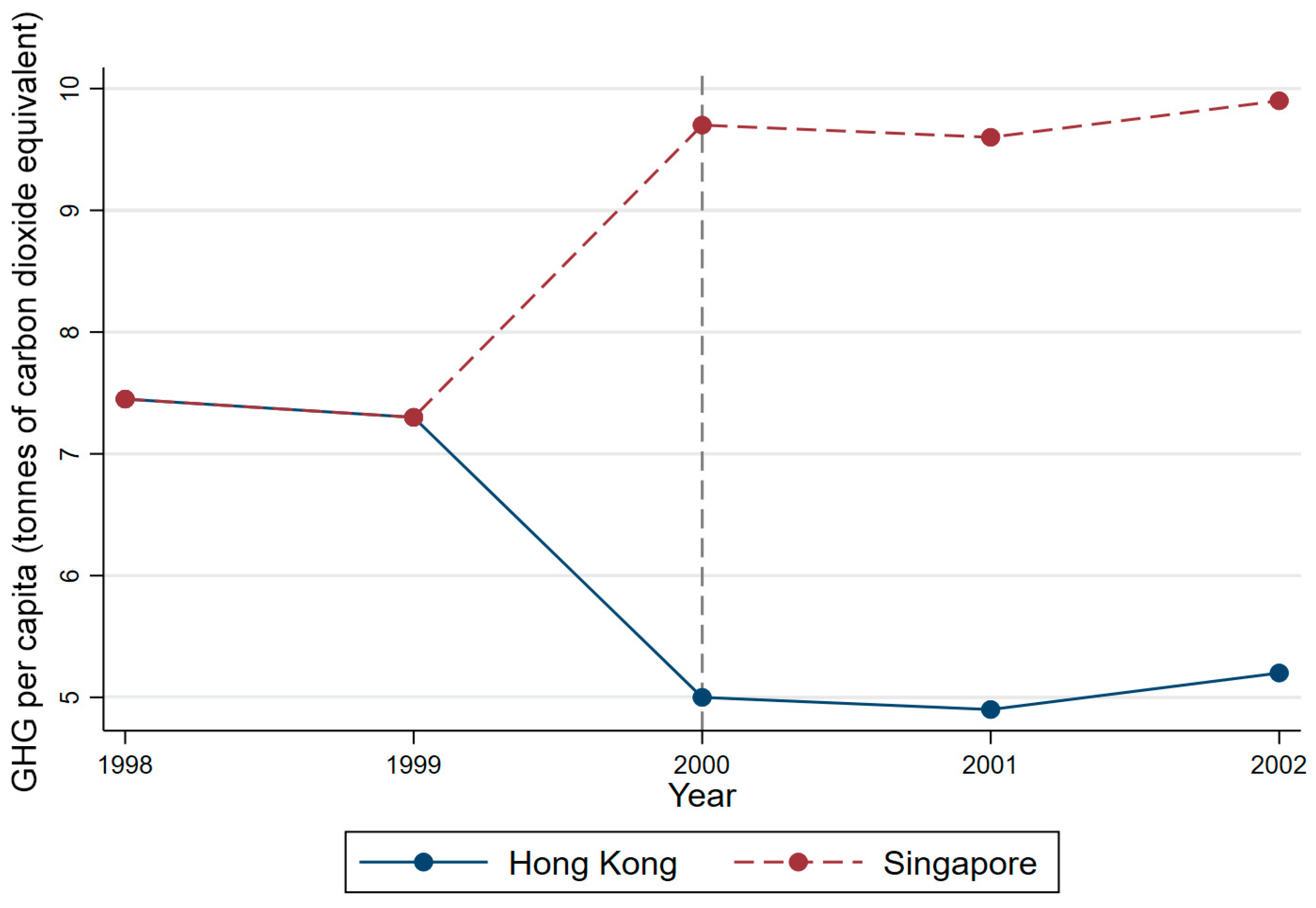
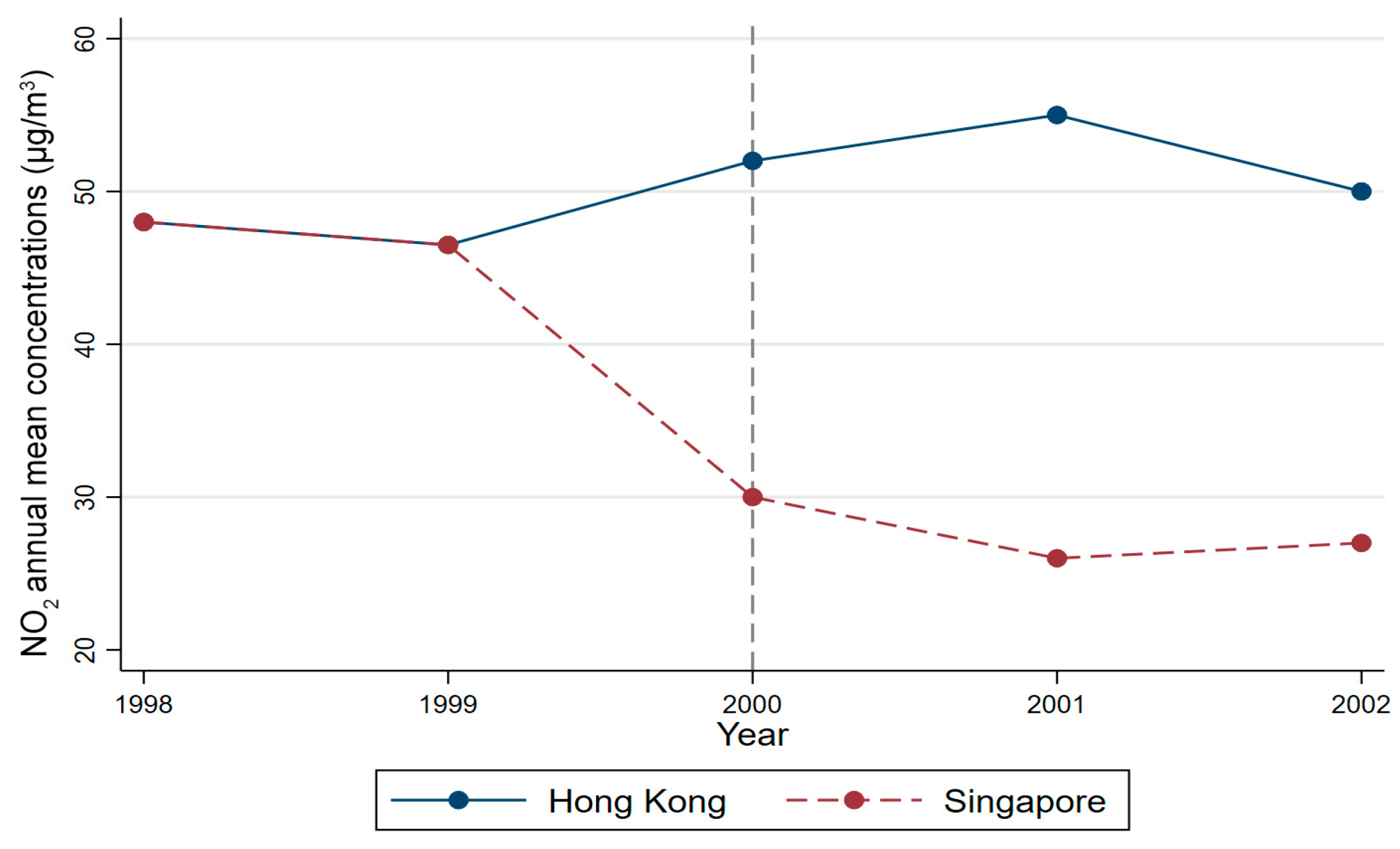
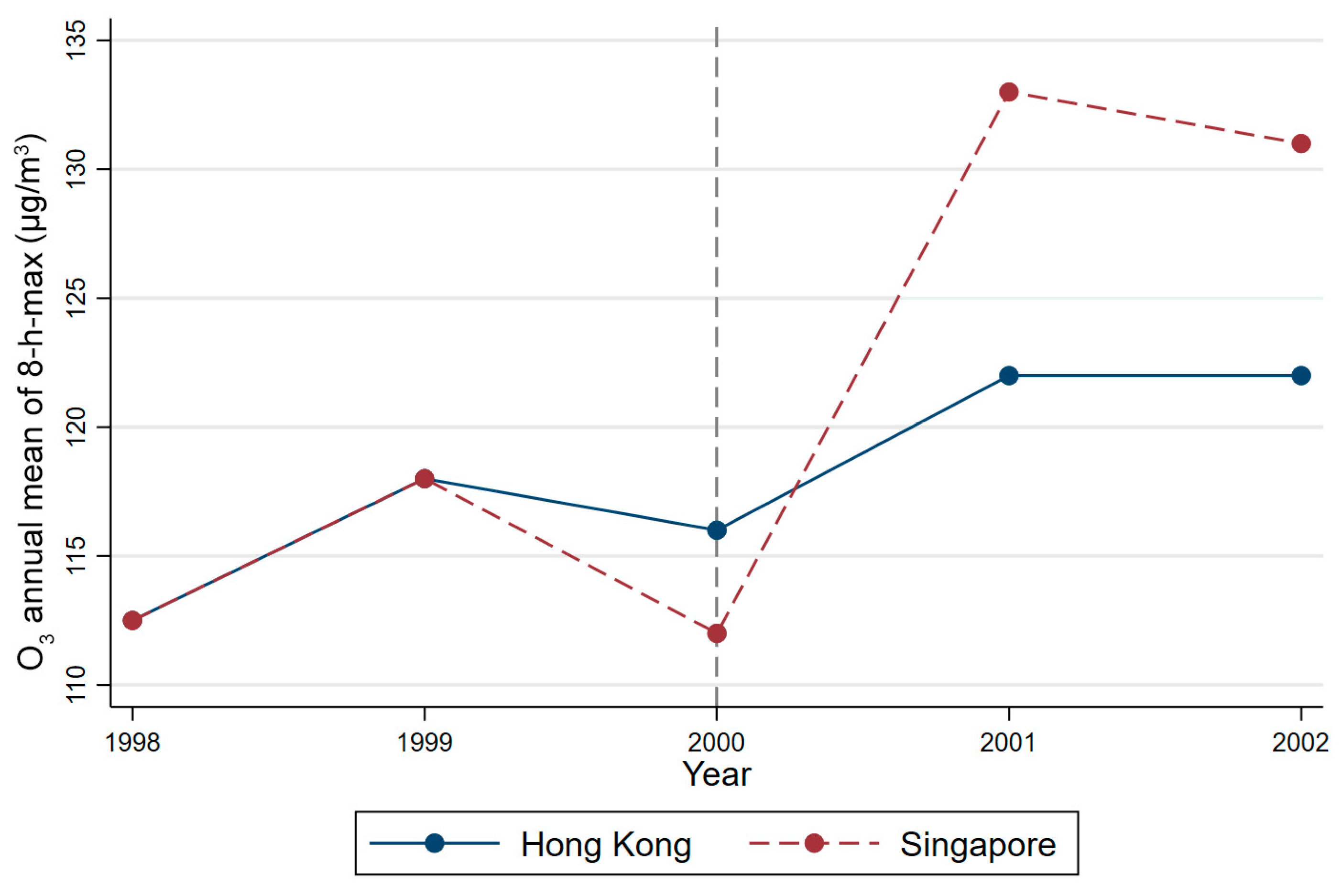

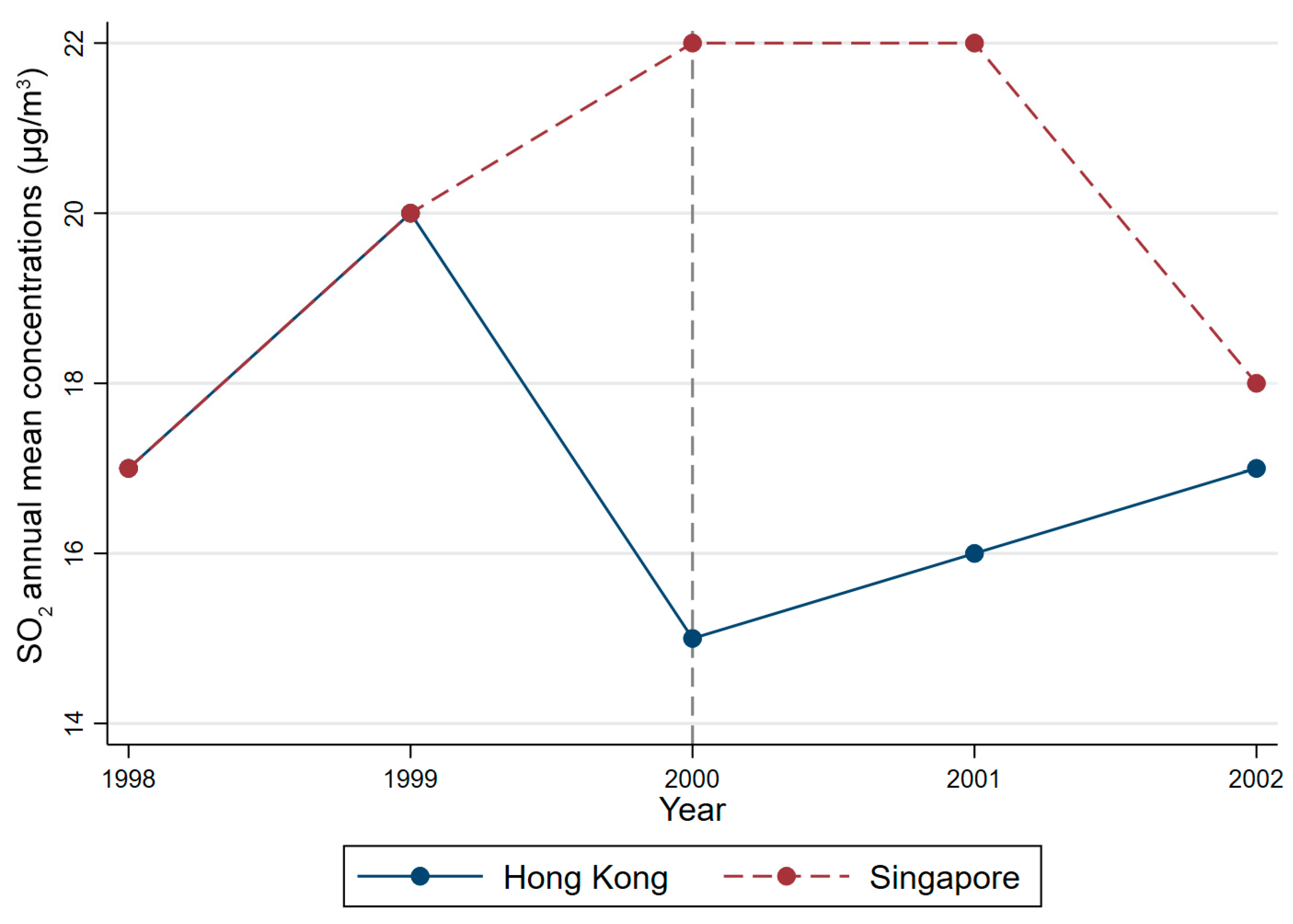




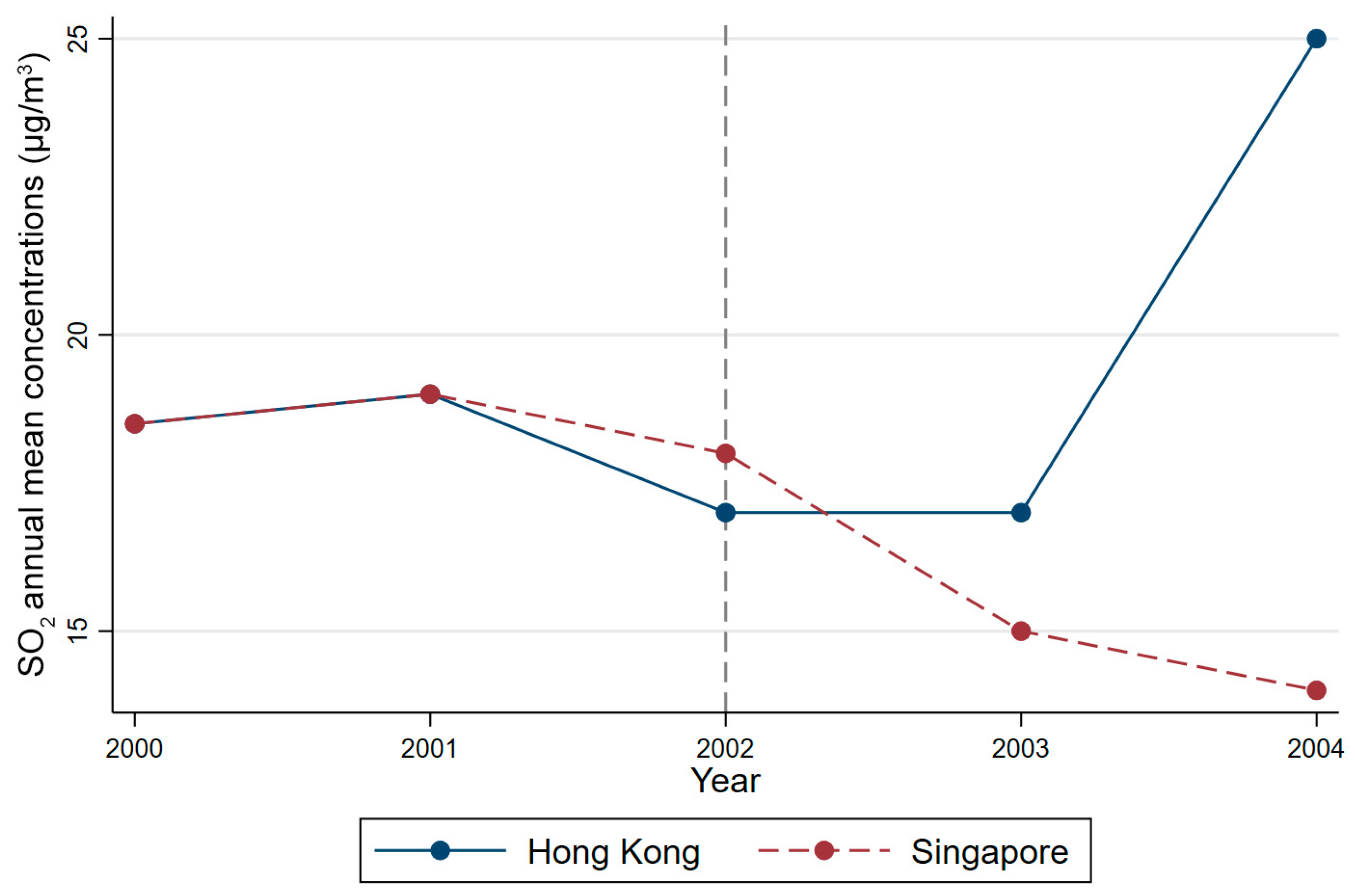
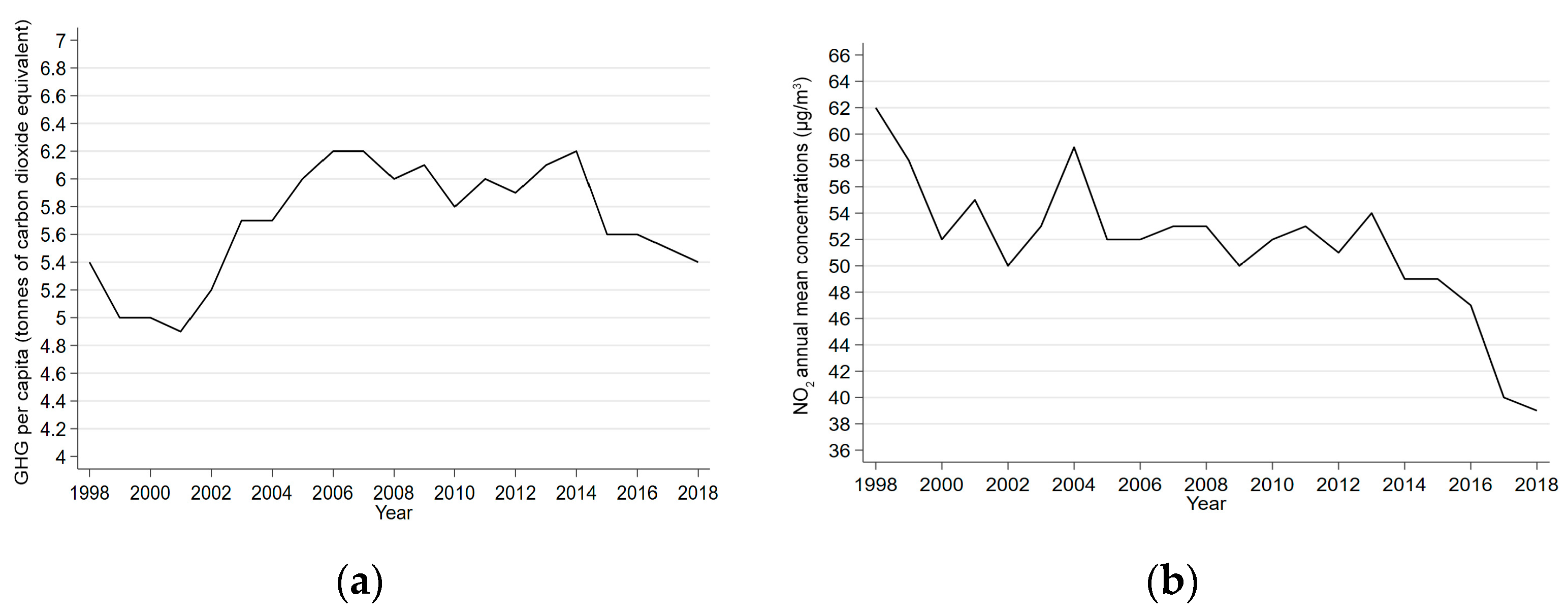
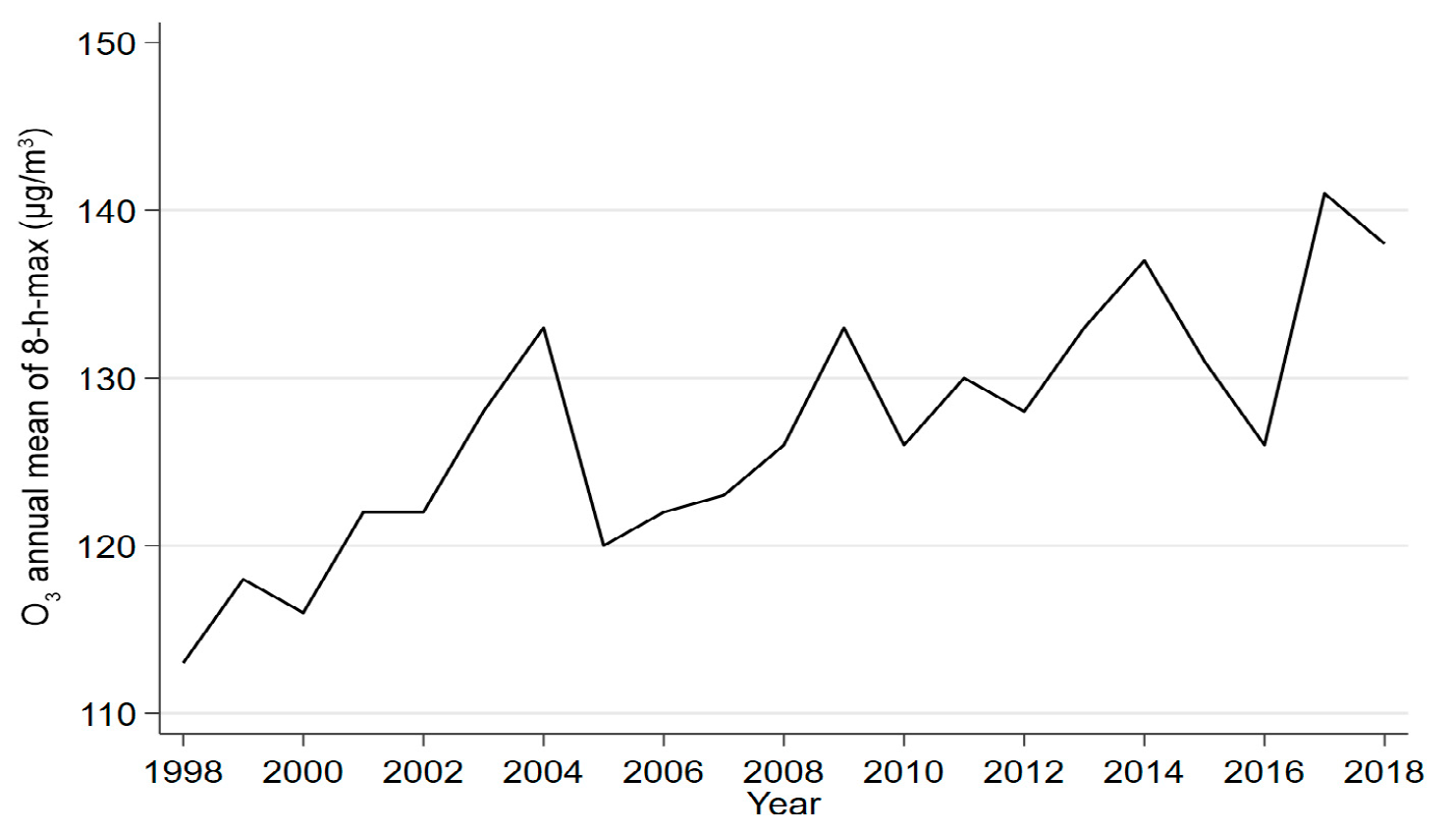


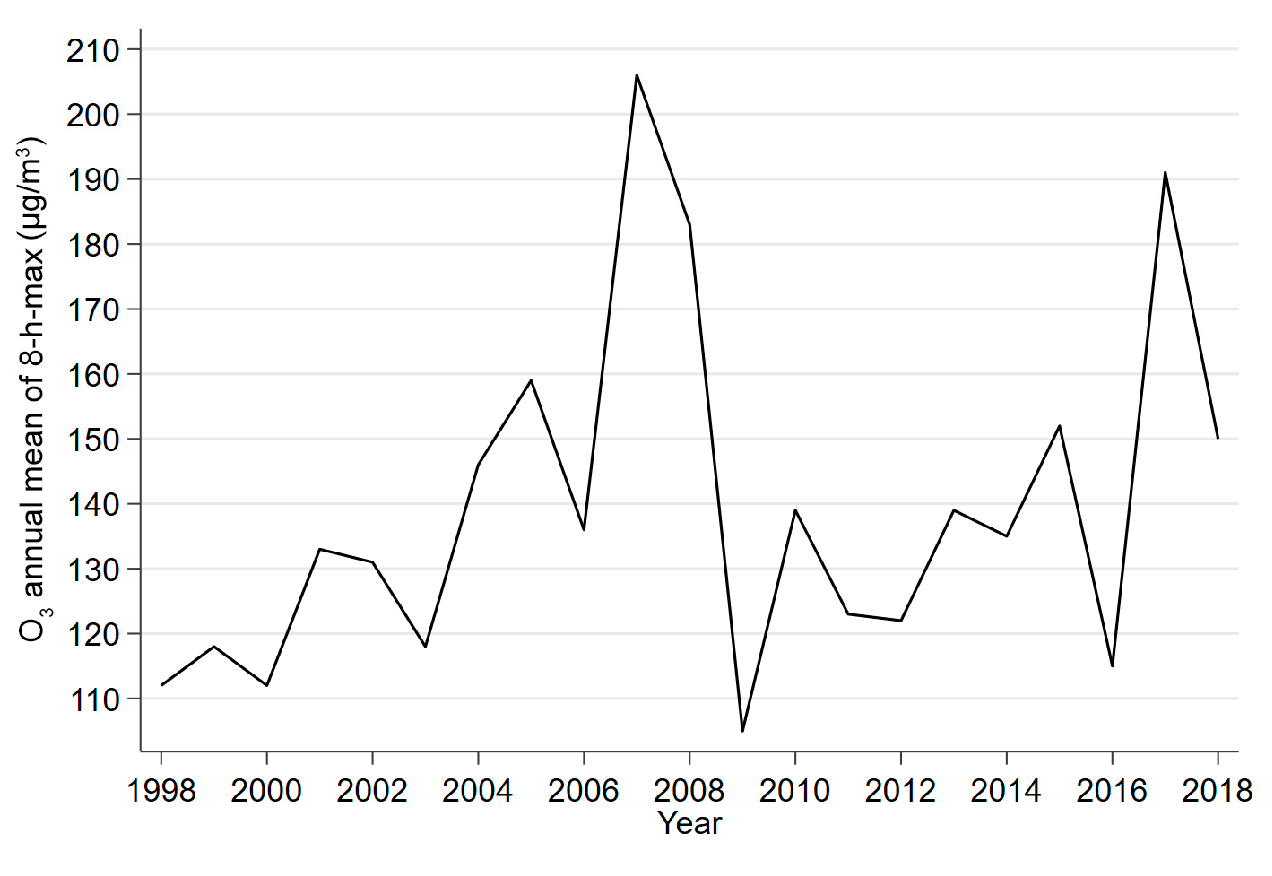

| Index | Factor | Hong Kong | Singapore | Sub-Category |
|---|---|---|---|---|
| 1 | Population | √ | √ | Demographic factors |
| 2 | GDP | √ | √ | Economic scale |
| 3 | GDP growth rate | √ | √ | |
| 4 | GDP per capita | √ | √ | |
| 5 | Industrial output | √ | √ | Scale and proportion of secondary industry |
| 6 | Proportion of secondary industry | √ | √ | |
| 7 | Total energy consumption | √ | √ | Energy consumption |
| 8 | Total power consumption | √ | √ | |
| 9 | Number of motor vehicles | √ | √ | Motor vehicle exhaust |
| 10 | Number of ships | √ | √ | Ship exhaust |
| 11 | The ratio of urban built-up area to that of the city | √ | √ | Urbanisation |
| 12 | Environmental governance funds | √ | √ | Environmental policy |
| Symbols | Control Variables | Descriptions | Unit of Measure |
|---|---|---|---|
| GDP per capita | Logarithm of GDP per capita | Current U.S. dollar per person | |
| The annual cargo-handling by cargo vessels | Logarithm of annual cargo-handling by cargo vessels | Thousand tonnes | |
| The annual container-handling by container vessels | Logarithm of annual container-handling by container vessels | Thousand twenty-foot equivalent units | |
| The population density | Logarithm of population density | People per square kilometre | |
| The annual electricity consumption of industry (including construction) | Logarithm of annual electricity consumption of industry (including construction) | Ten thousand kilowatt-hours | |
| The annual passenger traffic by passenger vessels | Logarithm of annual passenger traffic by passenger vessels | Thousand passengers | |
| The annual added value of industry (including construction) | Logarithm of annual added value of industry (including construction) | Percentage | |
| The number of motor vehicles | Logarithm of number of motor vehicles | Vehicle |
| Variables | GHG | NO2 | O3 | PM10 | SO2 | Policy | Post | DID |
| Mean | 1.948 | 3.71 | 4.783 | 3.707 | 2.9 | - | 0.4 | 0.2 |
| Std.Dev. | 0.338 | 0.335 | 0.061 | 0.219 | 0.165 | - | 0.516 | 0.422 |
| Min | 1.589 | 3.258 | 4.718 | 3.401 | 2.639 | 0 | 0 | 0 |
| Max | 2.293 | 4.127 | 4.890 | 3.951 | 3.091 | 1 | 1 | 1 |
| Sum | 19.483 | 37.095 | 47.833 | 37.067 | 29.003 | - | 4 | 2 |
| Sum Sq. Dev. | 1.069 | 1.061 | 0.193 | 0.693 | 0.521 | - | 1.633 | 1.333 |
| Observations | 10 | 10 | 10 | 10 | 10 | 10 | 10 | 10 |
| Variables | Capita | Cargo | Container | Density | Electricity | Passenger | Value | Vehicle |
| Mean | 10.075 | 12.381 | 9.717 | 8.721 | 13.487 | 9.993 | 2.966 | 13.302 |
| Std.Dev. | 0.074 | 0.322 | 0.085 | 0.039 | 0.43 | 1.287 | 0.508 | 0.16 |
| Min | 9.985 | 12.027 | 9.588 | 8.661 | 13.012 | 8.636 | 2.365 | 13.124 |
| Max | 10.158 | 12.722 | 9.86 | 8.768 | 13.992 | 11.254 | 3.48 | 13.471 |
| Sum | 100.745 | 123.81 | 97.171 | 87.214 | 134.868 | 99.933 | 29.663 | 133.016 |
| Sum Sq. Dev. | 0.233 | 1.017 | 0.270 | 0.123 | 1.360 | 4.071 | 1.605 | 0.506 |
| Observations | 10 | 10 | 10 | 10 | 10 | 10 | 10 | 10 |
| Variables | GHG | NO2 | O3 | PM10 | SO2 | Policy | Post | DID |
| Mean | 1.978 | 3.631 | 4.834 | 3.688 | 2.879 | - | 0.4 | 0.2 |
| Std.Dev. | 0.333 | 0.378 | 0.079 | 0.282 | 0.194 | - | 0.516 | 0.422 |
| Min | 1.589 | 3.178 | 4.718 | 3.332 | 2.639 | 0 | 0 | 0 |
| Max | 2.322 | 4.078 | 4.984 | 4.094 | 3.219 | 1 | 1 | 1 |
| Sum | 19.780 | 36.310 | 48.342 | 36.875 | 28.786 | - | 4 | 2 |
| Sum Sq. Dev. | 1.053 | 1.195 | 0.250 | 0.891 | 0.612 | - | 1.632993 | 1.333333 |
| Observations | 10 | 10 | 10 | 10 | 10 | 10 | 10 | 10 |
| Variables | Capita | Cargo | Container | Density | Electricity | Passenger | Value | Vehicle |
| Mean | 10.099 | 12.459 | 9.83 | 8.732 | 13.493 | 10.02 | 2.898 | 13.321 |
| Std.Dev. | 0.07 | 0.312 | 0.109 | 0.037 | 0.508 | 1.247 | 0.574 | 0.159 |
| Min | 9.985 | 12.07 | 9.653 | 8.683 | 12.93 | 8.767 | 2.216 | 13.155 |
| Max | 10.226 | 12.883 | 9.998 | 8.773 | 14.014 | 11.25 | 3.48 | 13.497 |
| Sum | 100.985 | 124.591 | 98.301 | 87.319 | 134.928 | 100.199 | 28.980 | 133.215 |
| Sum Sq. Dev. | 0.222 | 0.985 | 0.344 | 0.116 | 1.606 | 3.945 | 1.816 | 0.503 |
| Observations | 10 | 10 | 10 | 10 | 10 | 10 | 10 | 10 |
| Variables | GHG | NO2 | O3 | PM10 | SO2 | Policy | Capita |
| Mean | 1.736 | 3.938 | 4.842 | 3.842 | 2.645 | - | 10.37 |
| Std.Dev. | 0.075 | 0.108 | 0.058 | 0.167 | 0.367 | - | 0.232 |
| Min | 1.589 | 3.664 | 4.727 | 3.497 | 1.792 | 0 | 10.085 |
| Max | 1.825 | 4.127 | 4.949 | 4.094 | 3.219 | 1 | 10.793 |
| Sum | 36.459 | 82.690 | 101.686 | 80.672 | 55.538 | - | 217.765 |
| Sum Sq. Dev. | 0.344 | 0.495 | 0.267 | 0.764 | 1.680 | - | 1.064 |
| Observations | 21 | 21 | 21 | 21 | 21 | 21 | 21 |
| Variables | Cargo | Container | Density | Electricity | Passenger | Value | Vehicle |
| Mean | 12.359 | 9.941 | 8.8 | 12.815 | 13.795 | 2.115 | 13.305 |
| Std.Dev. | 0.182 | 0.138 | 0.039 | 0.188 | 0.056 | 0.242 | 0.149 |
| Min | 12.027 | 9.588 | 8.737 | 12.637 | 13.703 | 1.866 | 13.124 |
| Max | 12.604 | 10.106 | 8.867 | 13.149 | 13.904 | 2.614 | 13.573 |
| Sum | 259.535 | 208.767 | 184.806 | 269.123 | 289.693 | 44.421 | 279.410 |
| Sum Sq. Dev. | 0.834 | 0.633 | 0.177 | 0.862 | 0.256 | 1.108 | 0.681 |
| Observations | 21 | 21 | 21 | 21 | 21 | 21 | 21 |
| Variables | GHG | NO2 | O3 | PM10 | SO2 | Policy | Capita |
| Mean | 2.236 | 3.235 | 4.92 | 3.395 | 2.607 | - | 10.537 |
| Std.Dev. | 0.049 | 0.127 | 0.182 | 0.116 | 0.28 | - | 0.405 |
| Min | 2.128 | 3.091 | 4.654 | 3.219 | 2.197 | 0 | 9.985 |
| Max | 2.322 | 3.555 | 5.328 | 3.611 | 3.091 | 1 | 11.076 |
| Sum | 46.957 | 67.939 | 103.323 | 71.291 | 54.745 | - | 221.284 |
| Sum Sq. Dev. | 0.223 | 0.584 | 0.834 | 0.530 | 1.284 | - | 1.857 |
| Observations | 21 | 21 | 21 | 21 | 21 | 21 | 21 |
| Variables | Cargo | Container | Density | Electricity | Passenger | Value | Vehicle |
| Mean | 13.029 | 10.117 | 8.816 | 14.242 | 8.81 | 3.318 | 13.64 |
| Std.Dev. | 0.247 | 0.294 | 0.114 | 0.259 | 0.063 | 0.119 | 0.145 |
| Min | 12.652 | 9.625 | 8.661 | 13.788 | 8.636 | 3.151 | 13.431 |
| Max | 13.354 | 10.508 | 8.962 | 14.582 | 8.92 | 3.48 | 13.789 |
| Sum | 273.614 | 212.458 | 185.132 | 299.085 | 185.008 | 69.678 | 286.440 |
| Sum Sq. Dev. | 1.131 | 1.349 | 0.522 | 1.185 | 0.289 | 0.545 | 0.664 |
| Observations | 21 | 21 | 21 | 21 | 21 | 21 | 21 |
| Variables | GHG | NO2 | O3 | PM10 | SO2 |
|---|---|---|---|---|---|
| DID | 0.178 | −0.541 | −0.123 | −0.398 | −1.032 |
| Time | −0.0858 | 0.244 | 0.0792 | 0.302 | 0.0258 |
| Policy | −0.00175 | −0.178 | 0.0218 | −0.120 | 0.629 |
| o. Density | - | - | - | - | - |
| Capita | 1.176 | −1.576 | −2.055 | −0.932 | −9.782 |
| o. Value | - | - | - | - | - |
| Electricity | −0.558 | 2.117 | 0.857 | 2.003 | 1.811 |
| Vehicle | 0.678 | −4.238 | −0.116 | −5.895 | 0.263 |
| Passenger | 0.0286 | 0.118 | 0.194 | −0.350 | 0.450 |
| Cargo | 1.627 | −0.992 | −0.599 | −1.514 | −2.209 |
| Container | −0.870 | 0.411 | 0.445 | 1.074 | 1.080 |
| Constant | −23.37 | 54.57 | 16.60 | 76.30 | 85.89 |
| Observations | 10 | ||||
| R-squared | 1.000 | ||||
| Variables | GHG | NO2 | O3 | PM10 | SO2 |
|---|---|---|---|---|---|
| DID | 0.106 | 0.326 | −0.232 | 0.252 | 1.569 |
| Time | −0.00254 | −0.357 | 0.221 | −0.293 | −0.968 |
| (0) | (0) | (0) | (0) | (0) | |
| Policy | 0.0653 | −0.107 | −0.185 | −0.260 | 0.802 |
| o. Density | - | - | - | - | - |
| Capita | 0.00258 | 2.721 | −3.557 | 0.116 | 16.77 |
| Value | 0.161 | −1.957 | 2.320 | −0.837 | −9.643 |
| Electricity | 0.228 | −0.186 | −0.378 | −0.447 | 4.242 |
| o. Vehicle | - | - | - | - | - |
| Passenger | −0.0928 | −0.980 | 2.080 | −0.347 | −3.957 |
| Cargo | 0.169 | −0.901 | 4.070 | 0.0989 | −3.098 |
| Container | 0.0194 | 0.244 | −1.312 | 1.172 | −7.620 |
| Constant | −3.004 | 3.092 | −19.50 | 1.836 | −42.73 |
| Observations | 10 | ||||
| R-squared | 1.000 | ||||
| Variables | GHG | NO2 | O3 | PM10 | SO2 |
|---|---|---|---|---|---|
| Density | −8.400 ** | −21.98 ** | 6.219 | −18.18 *** | −6.146 |
| Capita | 0.0705 | −0.00836 | −0.905 *** | −0.734 * | 0.520 |
| Value | −0.647 *** | −0.0922 | −0.0720 | −0.768 * | 0.0764 |
| Electricity | 2.130 * | 3.517 | −1.807 | 3.556 | 16.70 ** |
| Vehicle | 3.894 * | 10.87 * | −3.314 | 8.853 ** | 23.73 * |
| Passenger | −4.172 | −9.824 | 4.735 | −7.378 | −37.79 ** |
| Cargo | 0.852 *** | −0.0966 | 0.500 * | 0.435 | 1.177 |
| Container | −0.537 ** | 0.161 | −0.367 | −0.0662 | −0.459 |
| 1. Policy | 0.0343 | −0.0393 | −0.0356 | −0.0714 * | −0.0631 |
| Constant | 49.55 ** | 143.1 ** | −40.94 * | 106.8 *** | 32.87 |
| Observations | 21 | ||||
| R-squared | 0.950 | 0.830 | 0.875 | 0.967 | 0.941 |
| Variables | GHG | NO2 | O3 | PM10 | SO2 |
|---|---|---|---|---|---|
| Density | −0.571 | 1.718 | −3.205 | 2.109 | −0.342 |
| Capita | 0.398 ** | 0.801 ** | −0.407 | 0.199 | 1.034 |
| Value | −0.0246 | 0.180 | −1.363 | 1.119 | −2.671 ** |
| Electricity | 0.371 ** | −1.186 *** | 0.570 | −0.658 | −0.188 |
| Vehicle | −0.790 ** | −2.263 *** | −0.536 | −0.701 | −2.991 * |
| Passenger | 0.0787 | −0.547 * | 0.586 | −0.335 | 0.229 |
| Cargo | −0.315 | 0.663 | 1.156 | 0.257 | −1.643 |
| Container | −0.125 | −0.333 | 0.231 | −0.137 | −0.102 |
| 1. Policy | 0.0139 | −0.0100 | 0.0260 | 0.0548 | 0.0353 |
| Constant | 13.32 *** | 26.37 ** | 18.61 | −1.110 | 67.47 *** |
| Observations | 21 | ||||
| R-squared | 0.874 | 0.898 | 0.571 | 0.498 | 0.886 |
Publisher’s Note: MDPI stays neutral with regard to jurisdictional claims in published maps and institutional affiliations. |
© 2022 by the authors. Licensee MDPI, Basel, Switzerland. This article is an open access article distributed under the terms and conditions of the Creative Commons Attribution (CC BY) license (https://creativecommons.org/licenses/by/4.0/).
Share and Cite
Zhang, R.; Xu, Y. The Air Quality Impact Evaluation of Modular Construction Practices in Hong Kong and Singapore. Sustainability 2022, 14, 1016. https://doi.org/10.3390/su14021016
Zhang R, Xu Y. The Air Quality Impact Evaluation of Modular Construction Practices in Hong Kong and Singapore. Sustainability. 2022; 14(2):1016. https://doi.org/10.3390/su14021016
Chicago/Turabian StyleZhang, Riqi, and Yishuang Xu. 2022. "The Air Quality Impact Evaluation of Modular Construction Practices in Hong Kong and Singapore" Sustainability 14, no. 2: 1016. https://doi.org/10.3390/su14021016






